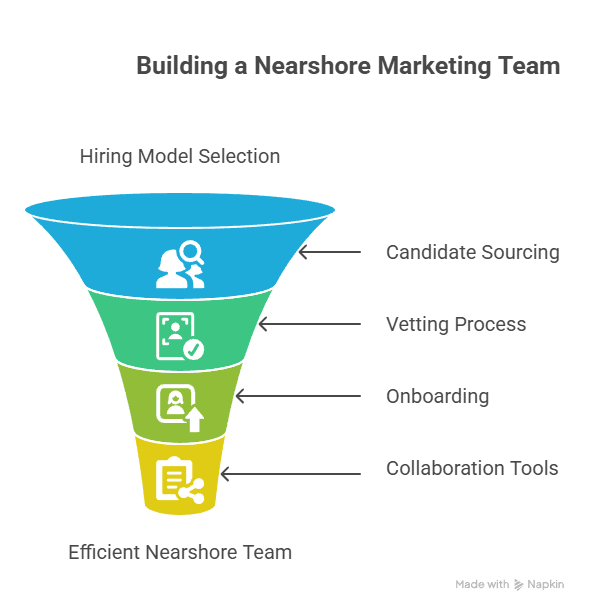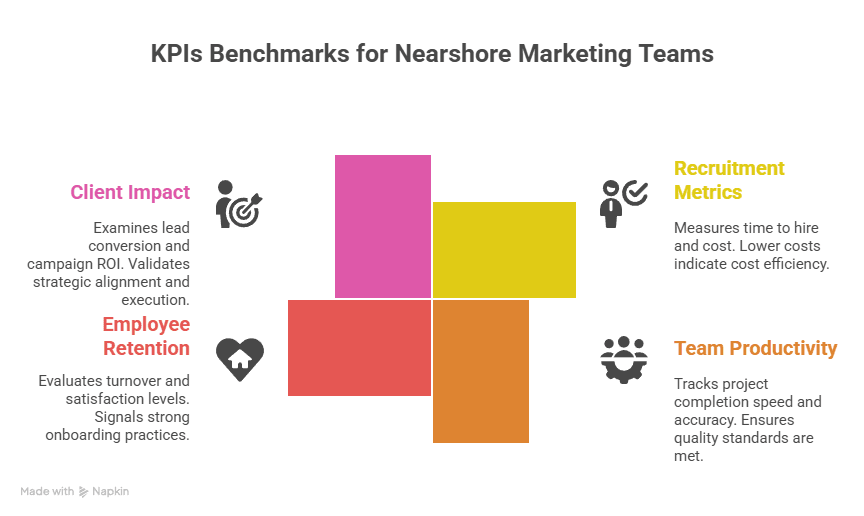Expanding your marketing operations with a nearshore team in LATAM offers a strategic advantage for businesses seeking cost efficiency, skilled talent, and cultural alignment. Latin America has become a hub for companies looking to scale their marketing efforts without compromising quality or collaboration. Its proximity to the U.S. ensures seamless communication and overlapping work hours, making it an ideal region for nearshoring.
By building a marketing team in LATAM, you gain access to diverse expertise in digital strategy, content creation, social media management, and analytics, all tailored to meet global standards. The region’s growing pool of bilingual professionals also bridges language barriers while fostering innovation.
If you’re exploring ways to optimize resources and enhance your marketing capabilities, this is the right place to understand how to establish and manage a nearshore team.
What is a Nearshore Marketing Team?
A nearshore marketing team consists of professionals located in neighboring or nearby countries, offering services to your business with minimal time zone differences. In the context of LATAM, this typically involves hiring skilled marketers from countries like Costa Rica, Colombia, or Argentina to support your operations in the US.
Recruiters and hiring managers often nearshore talent for roles such as digital strategists, content creators, SEO specialists, and social media managers. These teams work collaboratively with your in-house staff while providing cost-effective solutions compared to onshore hires.
Nearshore staffing agencies streamline processes by screening candidates for language proficiency, cultural compatibility, and technical expertise. This ensures you onboard employees who align with your brand’s goals and communication style.
Hiring nearshore marketers helps CEOs scale campaigns without overextending budgets. Proximity allows seamless collaboration through real-time communication tools like Slack or Zoom. Also, bilingual employees can bridge linguistic gaps when targeting diverse markets across North America and LATAM.
By outsourcing specific functions to a nearshore team, you delegate tasks like campaign management or analytics tracking while retaining control over strategic decisions.
How to Build a Nearshore Marketing Team in LATAM?
Building a nearshore marketing team in Latin America is not just about hiring cheaper talent. Done properly, it’s a structured operational initiative that aligns recruitment, vetting, onboarding, and workflow systems with your revenue goals.
The objective is to assemble a team that performs at the same—or higher—level as a domestic team, without creating management drag.

1. Hiring Models That Fit Your Growth Stage
The right hiring model depends on your operational horizon, budget, and control requirements. Avoid defaulting to one approach—define your criteria first.
- Direct Hire (Permanent Employment): Best if you want long-term stability and plan to integrate the hire into your company culture. You manage payroll, compliance, and benefits locally or through an Employer of Record (EOR) in the LATAM country.
- Agency-Managed (Contract): Suitable for rapid scaling or testing roles before committing. The staffing partner handles contracts, compliance, and in some cases, training and performance tracking.
Execution Tip:
List the marketing functions you want to cover in the next 12 months—SEO, paid media, email marketing, creative production, analytics—and decide which require embedded, full-time specialists versus flexible, project-based resources. A mixed model is often optimal.
2. A Vetting Process That Filters for Both Skill and Fit
Technical skill alone is insufficient for a nearshore hire to succeed. A structured vetting framework should include:
- Pre-Screening – Review portfolios, campaign case studies, and measurable results (e.g., CTR improvements, ROAS gains). Discard candidates without hard performance metrics.
- Technical Assessments – Use role-specific tests: SEO audits, ad copy creation, campaign build exercises, or data analysis tasks in Google Analytics.
- Communication Testing – Evaluate bilingual fluency through live conversations and written exercises to simulate day-to-day communication.
- Workflow Compatibility – Ask scenario-based questions about managing tasks across time zones, reporting to multiple stakeholders, and adapting to shifting priorities.
Execution Tip:
If you use a staffing agency, require them to share the full vetting criteria they use. Push for video recordings of interviews and raw test results before making a decision.
3. Onboarding That Speeds Time-to-Productivity
An unstructured onboarding process is the fastest way to waste a good hire. A functional onboarding playbook should cover:
- Role Clarity: Define KPIs, reporting lines, and success benchmarks within the first week.
- Process Orientation: Walk them through campaign planning cycles, approval processes, and how cross-departmental work is handled.
- Tool Access: Provide logins to ad platforms, CRMs, analytics dashboards, and design tools before day one.
- Mentorship: Assign an internal point of contact for questions, feedback, and escalation.
- Performance Milestones: Set 30-, 60-, and 90-day goals tied to measurable output, not just task completion.
Execution Tip:
Automate repetitive onboarding steps with checklists and recorded process videos so you can scale hiring without slowing delivery.
4. Collaboration Stack That Eliminates Bottlenecks
Distributed teams fail when tools are mismatched to workflows. Your collaboration stack should support both synchronous and asynchronous communication:
- Messaging: Slack or Microsoft Teams for quick updates, integrated with project boards to keep context.
- Project Management: Asana, ClickUp, or Trello for assigning deliverables, tracking timelines, and centralizing feedback.
- File Sharing: Google Drive or Dropbox Business with clear folder structures and naming conventions.
- Video Conferencing: Zoom or Google Meet for weekly stand-ups, monthly performance reviews, and campaign post-mortems.
- Campaign Reporting: Shared dashboards in Data Studio or Looker for real-time visibility into KPIs.
Execution Tip:
Limit your core stack to 4–5 tools and train everyone on standardized usage rules. Tool sprawl leads to fractured communication and missed deadlines.
5. Building a Cost Model
When forecasting, factor in:
- Base Compensation – Varies significantly by role and country. For example, a mid-level PPC specialist may earn $1,200–$1,800/month in Colombia, while in Mexico, the range can be $1,500–$2,200.
- Mandatory Benefits – Many LATAM countries require employer contributions for social security, vacation pay, and 13th-month salary (aguinaldo). These can add 25–40% on top of salary.
- Recruitment Fees – If using an agency, expect 15–25% of the annual salary for direct hire, or a monthly management fee for contract models.
- Tools and Licenses – Allocate $50–$150/month per employee for required software (ad platforms, project management tools, design licenses).
- Exchange Rate Fluctuation – Build a 5–10% buffer in your budget to cover currency volatility.
Execution Tip:
Create a per-role cost sheet in Google Sheets, with columns for salary, benefits, tools, and buffers, so you can compare total cost across countries before committing.
6. Compliance and Legal Options
Operating without proper legal structure can trigger fines, tax liabilities, or reputational damage. Your options include:
- Direct Employment in Country – Requires registering a legal entity and handling payroll locally. Best for larger teams.
- Employer of Record (EOR) – A third-party handles contracts, benefits, and compliance under their local entity. Fast to set up; adds a service fee but avoids legal complexity.
- Independent Contractor Agreements – Works for project-based or part-time roles but offers less control over schedule and output. Some countries are strict about reclassifying contractors as employees if they meet certain criteria.
Execution Tip:
Have contracts reviewed by a local labor attorney or your EOR before onboarding. Include clauses for IP ownership, confidentiality, and jurisdiction of disputes.
How U.S. Companies are Scaling with LATAM Nearshore Marketing Teams
U.S. companies scale marketing operations by leveraging nearshore teams in LATAM for cost-effective talent acquisition and operational efficiency. Recruiters source bilingual professionals skilled in digital strategy, SEO, content creation, and social media management to fill critical roles without the high costs of onshore hiring.
1. Access Skilled Talent Quickly
Hiring managers streamline recruitment by partnering with nearshore staffing agencies that specialize in sourcing pre-vetted candidates from countries like Mexico, Colombia, and Argentina. These agencies assess technical skills, cultural fit, and language proficiency before shortlisting candidates for interviews.
2. Reduce Recruitment Costs
Outsourcing specific marketing functions to LATAM reduces overhead expenses tied to salaries and benefits. By recruiting contract employees or full-time staff at competitive rates, CEOs allocate resources efficiently while maintaining quality output.
3. Minimize Time Zone Challenges
LATAM’s proximity ensures overlapping work hours between your team and U.S.-based leadership. Real-time communication tools support seamless collaboration during project execution, eliminating delays caused by time zone gaps often seen with offshore teams.
4. Retain Bilingual Professionals for Market Expansion
Bilingual employees bridge language barriers when targeting Spanish-speaking markets across North America and Latin America. Their expertise enhances localized campaigns while aligning messaging with regional preferences.
5. Scale Campaigns Without Overextending Internal Teams
Delegating tasks such as paid media management or email marketing automation allows your internal team to focus on strategic initiatives. Assigning these responsibilities to a nearshore team optimizes workload distribution without compromising campaign performance metrics.
By integrating a LATAM nearshore marketing team into your operations, you expand capacity while controlling costs and maintaining alignment with business goals.
KPIs and Performance Benchmarks for Nearshore Marketing Teams
Tracking the right KPIs ensures your nearshore marketing team in LATAM meets performance expectations. Clear benchmarks help hiring managers, CEOs, and recruiters evaluate success while identifying areas for improvement.

Common Recruitment Metrics to Track
- Time-to-Fill: Measure the average time to source, screen, and hire candidates for specific roles. For example, filling a digital strategist position should take 30-45 days with efficient processes.
- Cost-per-Hire: Calculate total recruitment expenses divided by hires made through nearshore staffing agencies or internal efforts. Lower costs compared to onshore hiring indicate cost efficiency.
- Candidate Quality Ratio: Assess how many sourced candidates pass screening stages like skills assessments or interviews. A higher ratio reflects effective sourcing strategies.
Team Productivity Indicators
- Campaign Turnaround Time: Track how quickly employees complete assigned projects such as content creation or ad optimization tasks within deadlines set by US-based leadership.
- Output Accuracy Rate: Monitor error rates in deliverables like SEO reports or social media analytics to ensure quality standards are met consistently.
- Utilization Rate: Analyze billable hours versus available working hours to determine if resources are optimally allocated across campaigns.
Employee Retention Metrics
- Attrition Rate: Evaluate employee turnover within your LATAM team over a specific period (e.g., quarterly). High retention signals strong onboarding and engagement practices.
- Engagement Scores: Use surveys to measure satisfaction levels among bilingual professionals managing diverse markets.
- Training Completion Rates: Track participation in upskilling programs designed for technical growth in areas like PPC management or data analysis.
Client Impact Measurements
- Lead Conversion Rates: Examine how effectively marketing initiatives generate qualified leads that convert into customers across North American and Spanish-speaking markets.
- ROI per Campaign: Compare campaign investment against revenue generated to validate strategic alignment between goals and execution.
- Customer Feedback Ratings: Collect feedback from stakeholders about communication effectiveness, cultural alignment, and overall collaboration with the nearshore team.
Defining these KPIs allows you to optimize operations, scale efficiently, and maintain accountability throughout your LATAM team’s lifecycle while aligning their contributions with business objectives seamlessly.
Final Thoughts: Nearshore Marketing in LATAM as a Growth Accelerator
Building a nearshore marketing team in LATAM offers you a strategic pathway to scale your operations efficiently while tapping into skilled talent and maintaining cost control. The region’s proximity, cultural alignment, and bilingual expertise create an environment where collaboration thrives and innovation flourishes.
Scale Army stands out as a top solution for US businesses looking to hire nearshore marketing talent. With a streamlined, hassle-free process, Scale Army connects you with highly skilled professionals in LATAM, enabling you to build a team that drives results without the complexity.
Take the first step toward scaling your marketing efforts—book a strategic call with Scale Army today and unlock the potential of nearshore talent for your business growth.
Frequently Asked Questions
Why should businesses consider building a nearshore team in LATAM?
Businesses benefit from cost efficiency, access to skilled talent, cultural alignment, and bilingual professionals. The region’s proximity to the U.S. ensures effective collaboration, making it ideal for scaling marketing operations without compromising quality.
What roles can be filled by a LATAM nearshore marketing team?
Roles include digital strategists, SEO specialists, content creators, social media managers, and other marketing professionals. Nearshore staffing agencies help source pre-vetted candidates tailored to specific business needs.
How does hiring a nearshore team reduce costs?
Nearshore teams offer lower labor costs compared to onshore hires while maintaining high-quality output. Additionally, reduced recruitment expenses and minimal time zone challenges further enhance operational efficiency.
What tools are essential for collaborating with a nearshore team?
Real-time communication tools (e.g., Slack or Zoom) and project management platforms (e.g., Trello or Asana) are crucial for ensuring seamless collaboration between U.S.-based teams and their LATAM counterparts.
How can companies ensure successful onboarding of a nearshore team?
Developing a structured onboarding plan that includes clear expectations, training resources, and regular check-ins helps integrate new hires quickly into the company culture and processes.
What KPIs should businesses track for their nearshore marketing team?
Key metrics include time-to-fill positions, cost-per-hire, candidate quality ratio, employee retention rates, productivity levels, and client impact measurements. Tracking these ensures accountability and optimization of operations.
Can outsourcing tasks to a LATAM team improve internal focus?
Yes! Delegating specific tasks like content creation or social media management allows internal teams to concentrate on strategic initiatives while ensuring campaigns run efficiently through the nearshore team.
Is cultural alignment an advantage when working with LATAM teams?
Absolutely! Cultural similarities between the U.S. and many Latin American countries promote smoother communication and stronger teamwork dynamics within cross-border collaborations.




